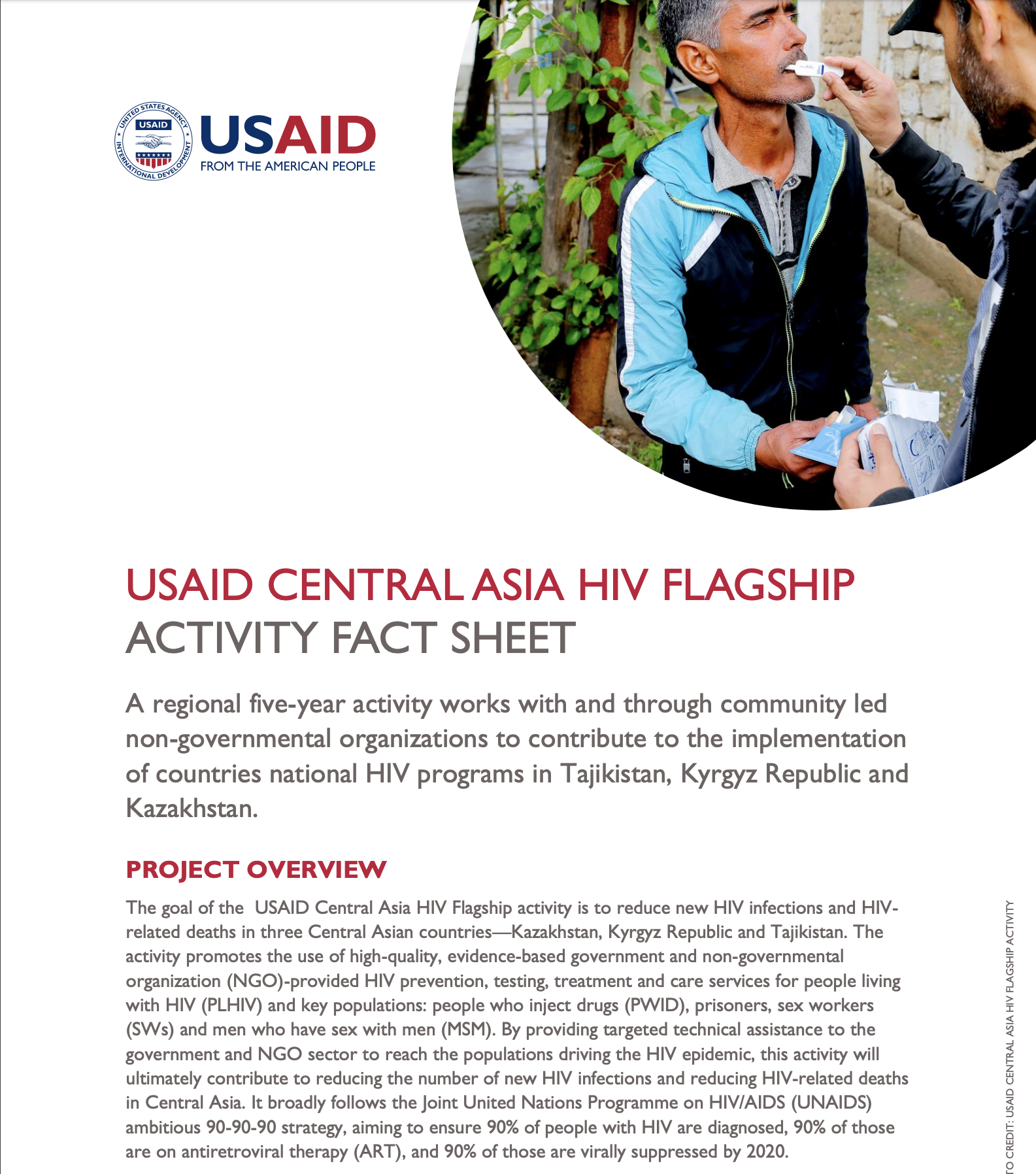Speeches Shim
USAID Central Asia HIV Flagship Activity ![]() (pdf - 395k)
(pdf - 395k)
A regional five-year activity works with and through community led non-governmental organizations to contribute to the implementation of countries national HIV programs in Tajikistan, Kyrgyz Republic and Kazakhstan.
Project Overview
The goal of the USAID Central Asia HIV Flagship activity is to reduce new HIV infections and HIV-related deaths in three Central Asian countries—Kazakhstan, Kyrgyz Republic and Tajikistan. The activity promotes the use of high-quality, evidence-based government and non-governmental organization (NGO)-provided HIV prevention, testing, treatment and care services for people living with HIV (PLHIV) and key populations: people who inject drugs (PWID), prisoners, sex workers (SWs) and men who have sex with men (MSM). By providing targeted technical assistance to the government and NGO sector to reach the populations driving the HIV epidemic, this activity will ultimately contribute to reducing the number of new HIV infections and reducing HIV-related deaths in Central Asia. It broadly follows the Joint United Nations Programme on HIV/AIDS (UNAIDS) ambitious 90-90-90 strategy, aiming to ensure 90% of people with HIV are diagnosed, 90% of those are on antiretroviral therapy (ART), and 90% of those are virally suppressed by 2020.
Activities
To contribute to achieving the 90-90-90 goals, the activity focuses its efforts on two key components in Central Asia: case-finding and linkage to services of undiagnosed HIV cases, and case management for ART initiation and adherence. The activity primarily supports and strengthens community partners working to improve services along the HIV testing and treatment cascade. Service delivery in the community happens primarily through peer navigators who work with local NGOs. Peer navigators are typically representatives from key populations and PLHIV who use their personal experiences to help their peers overcome internal and external barriers to be tested, linked to care and treatment services and to adhere to treatment. Peer navigators also work closely with the local AIDS Centers to find and bring back clients who miss their treatment appointment as well as invite clients who are still not on ART for community support. Community support includes individual and group sessions on topics such as ART, tuberculosis, drug abuse treatment including medication assisted therapy, and HIV prevention. Referral to these and other support services is also provided.
Achievements
Since its inception in December 2015, the USAID Central Asia HIV Flagship activity has significantly contributed to national HIV progress through community-led case finding and case management.
In Kazakhstan, HIV Flagship peer navigators have provided almost 10,000 people with HIV testing using rapid test kits - a testing modality that was not previously available - at the community level in Pavlodar and East Kazakhstan oblasts. Almost 600 people received their first positive HIV result through this community level testing; more than 500 became clients of community case management; and more than 400 started ART. A total of 1,347 former clients started the case management program, with approximately half starting ART. In addition, almost 2,600 PLHIV who were under the care of AIDS centers but not yet on ART, joined the case management program, with almost 2,000 initiating ART. HIV self-testing was introduced in Kazakhstan by the USAID Central Asia HIV Flagship activity in November 2019 to test partners of PLHIV. As of May 31, 2020, peer navigators distributed 412 tests, of which 392 reported back their results, including 57positive results indicating HIV infection.
In the Kyrgyz Republic, HIV Flagship peer navigators tested almost 60,000 people in Bishkek city, Chui oblast and Osh city and oblast and 1,250 of them received first positive results and almost 1,000 of them were enrolled in the community-based case management, of which almost 700 started ART. More than 700 PLHIV who were lost from HIV services were found by peer navigators and offered to join case management, of which more than 400 started ART. In addition, almost 1400 PLHIV clients of AIDS centers but not yet on ART joined community case management, and 840 of them started ART. In October 2019, the project launched HIV self-testing. Since this time, peer navigators distributed 763 self-test kits among partners of PLHIV and MSM with 475 results reported back, of which 24 reported positive results indicating HIV infection.
In Tajikistan, peer navigators tested almost 54,000 people in Dushanbe city, the Districts of Republican Subordination and Sughd oblast. Due to these efforts, more than 1,800 people received first positive HIV results, of which almost 1,400 enrolled in community case management, almost 1,200 started ART. Approximately 1,100 PLHIV who were lost from HIV services were found by peer navigators and offered to join community case management; more than 800 of them started ART. In addition, more than 800 PLHIV were referred by AIDS centers to start case management, and 700 of them started ART. HIV self-testing started in January 2020 among partners of PLHIV. Peer navigators distributed 1,337 tests with 1,169 people who reported back their results, of whom 51 were positive.
PROJECT DURATION: December 4, 2015-December 3, 2020
REGIONAL BUDGET: $21,400,000 (Kazakhstan’s budget: $4,000,000; Tajikistan’s budget: $8,900,000; Kyrgyz Republic’s budget: $8,500,000)
CONTACT: Khorlan Izmailova, USAID/Central Asia, email: kizmailova@usaid.gov


Comment
Make a general inquiry or suggest an improvement.